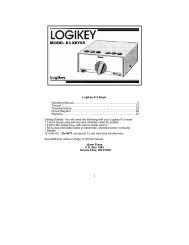4-BTV, 5-BTV, 6-BTV Multiband HF - K6RF Home of the Porta Base ...
4-BTV, 5-BTV, 6-BTV Multiband HF - K6RF Home of the Porta Base ...
4-BTV, 5-BTV, 6-BTV Multiband HF - K6RF Home of the Porta Base ...
Create successful ePaper yourself
Turn your PDF publications into a flip-book with our unique Google optimized e-Paper software.
Your location, landscape and ground conditions may require different mounting solutions in order<br />
to have <strong>the</strong> steel mounting pipe and <strong>the</strong> vertical antenna in a secure position. You may also attach<br />
<strong>the</strong> Tilt <strong>Base</strong> to a 4 to 6 inch wooden post at <strong>the</strong> location you intend to use <strong>the</strong> antenna, making sure<br />
<strong>the</strong> unit is securely mounted.<br />
Using a cyclone fence is not recommended for a vertical antenna support or being used as a radial<br />
system. Poor RF connections and <strong>the</strong> presence <strong>of</strong> high levels <strong>of</strong> noise that are inherent on metal<br />
fences make <strong>the</strong>m an undesirable mounting location for any <strong>HF</strong> vertical antenna.<br />
Note: Steel, ra<strong>the</strong>r than aluminum, is much more suitable for mounting in concrete. Aluminum<br />
will quickly corrode due to incompatibility with <strong>the</strong> materials used to make concrete.<br />
Concrete or No Concrete – That is THE Question<br />
The original Hustler <strong>BTV</strong> installation manuals call for <strong>the</strong> ground mounting pipe to be driven into<br />
<strong>the</strong> earth with <strong>the</strong> specific wording “Do not use concrete. Do not dig a hole and bury <strong>the</strong> mast. It<br />
must be driven in.” The reason for this recommendation is so that installations with few or no<br />
radials will be able to make use <strong>of</strong> <strong>the</strong> direct contact between <strong>the</strong> mounting pipe and <strong>the</strong> earth to<br />
collect and distribute antenna currents.<br />
Unfortunately, <strong>the</strong> soil and a steel pipe usually does not provide efficient RF conduction. Therefore,<br />
<strong>the</strong> use <strong>of</strong> many ground radial wires are recommended for all quarter-wave ground mounted <strong>HF</strong><br />
antenna, to improve efficiency and performance dramatically.<br />
Also, a driven or pounded pipe may be used on any ground-mounted vertical antenna installation,<br />
regardless <strong>of</strong> <strong>the</strong> number <strong>of</strong> radials used.<br />
DX Engineering recommends using a concrete base, as shown on page 9, when a high performance<br />
installation with many radials is planned. The reasons that a concrete base is recommended:<br />
1. It is easier to make sure that <strong>the</strong> mounting pipe is vertical when it is braced for installation<br />
with concrete. Pounded pipes can develop a lean or hit a rock while being driven into <strong>the</strong><br />
ground, which could result in a leaning antenna.<br />
2. A steel pipe or tube in concrete will last much longer than in soil, especially in certain types<br />
<strong>of</strong> soil that will corrode steel more quickly.<br />
3. Concrete is not an insulator for a steel pipe, as <strong>the</strong> hardened but moist concrete is a good<br />
conductor from <strong>the</strong> steel to <strong>the</strong> soil for grounding purposes.<br />
4. A ground surface wire radial system <strong>of</strong>fers far more efficient means to collect and distribute<br />
surface RF currents than a single pipe in <strong>the</strong> soil, so a pipe in concrete is okay when using<br />
many radials.<br />
- 10 -



